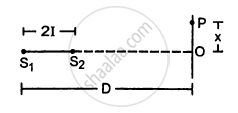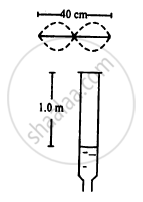Advertisements
Advertisements
Question
A car moves with a speed of 54 km h−1 towards a cliff. The horn of the car emits sound of frequency 400 Hz at a speed of 335 m s−1. (a) Find the wavelength of the sound emitted by the horn in front of the car. (b) Find the wavelength of the wave reflected from the cliff. (c) What frequency does a person sitting in the car hear for the reflected sound wave? (d) How many beats does he hear in 10 seconds between the sound coming directly from the horn and that coming after the reflection?
Solution
Given:
Velocity of car \[v_{car}\] = 54 kmh−1 = \[54 \times \frac{5}{18} = 15 {\text { ms }}^{- 1}\]
Frequency of the car f = 400 Hz
Velocity of sound in air \[v_{air}\]= 335 ms−1
Wavelength in front of the car \[\lambda\]=?
(a) Net velocity in front of the car \[v\] =\[v_{car} - v_{air}\]= 335\[-\]15 = 320 m/s
\[\text { As } v = f\lambda, \]
\[ \therefore \lambda = \frac{v}{f}\]
\[ \Rightarrow \lambda = \frac{320}{400} = 80 \text { cm }\]
(b) The frequency \[\left( f_1 \right)\] heard near the cliff is given by :
\[f_1 = \frac{v_{air}}{v_{air} + v_{car}} \times f_0 \]
\[ \Rightarrow f_1 = \frac{335}{335 + 5} \times 400\]
\[ \Rightarrow f_1 = \frac{335 \times 400}{320} \text{ Hz }\]
\[ \Rightarrow f_1 = 418 . 75 \text { Hz }\]
As we know,
\[v = f\lambda\]
\[\text { Wavelength reflected from the cliff is } \] \[\lambda = \frac{v}{f_1} = \frac{335}{418 . 75} = 80 \text { cm }\]
(c) Here,
\[v_0\]= 15 `\text { ms}^\(- 1)`
Frequency of the reflected sound wave \[\left( f_2 \right)\]heard by the person sitting in the car :
\[f_2 = \frac{v + v_0}{v} \times f_1 \]
\[ \Rightarrow f_2 = \frac{335 + 15}{335} \times \frac{335}{320} \times 400\]
\[ \Rightarrow f_2 = 437 \text{ Hz }\]
(d) He will not hear any beat in 10 seconds because the difference of frequencies is greater than 10 (persistence of sound for the human ear is 1/10 of a second).
APPEARS IN
RELATED QUESTIONS
Can you hear your own words if you are standing in a perfect vacuum? Can you hear your friend in the same conditions?
Two loudspeakers are arranged facing each other at some distance. Will a person standing behind one of the loudspeakers clearly hear the sound of the other loudspeaker or the clarity will be seriously damaged because of the 'collision' of the two sounds in between?
An electrically maintained tuning fork vibrates with constant frequency and constant amplitude. If the temperature of the surrounding air increases but pressure remains constant, the produced will have
(a) larger wavelength
(b) larger frequency
(c) larger velocity
(d) larger time period.
The sound level at a point 5.0 m away from a point source is 40 dB. What will be the level at a point 50 m away from the source?
Sound with intensity larger than 120 dB appears pain full to a person. A small speaker delivers 2.0 W of audio output. How close can the person get to the speaker without hurting his ears?
If the sound level in a room is increased from 50 dB to 60 dB, by what factor is the pressure amplitude increased?
A source S and a detector D are placed at a distance d apart. A big cardboard is placed at a distance \[\sqrt{2}d\] from the source and the detector as shown in figure. The source emits a wave of wavelength = d/2 which is received by the detector after reflection from the cardboard. It is found to be in phase with the direct wave received from the source. By what minimum distance should the cardboard be shifted away so that the reflected wave becomes out of phase with the direct wave?

Two coherent narrow slits emitting sound of wavelength λ in the same phase are placed parallel to each other at a small separation of 2λ. The sound is detected by moving a detector on the screen ∑ at a distance D(>>λ) from the slit S1 as shown in figure. Find the distance x such that the intensity at P is equal to the intensity at O.
Consider the situation shown in the figure.The wire which has a mass of 4.00 g oscillates in its second harmonic and sets the air column in the tube into vibrations in its fundamental mode. Assuming that the speed of sound in air is 340 m s−1, find the tension in the wire.

The fundamental frequency of a closed pipe is 293 Hz when the air in it is a temperature of 20°C. What will be its fundamental frequency when the temperature changes to 22°C?
A source of sound with adjustable frequency produces 2 beats per second with a tuning fork when its frequency is either 476 Hz of 480 Hz. What is the frequency of the tuning fork?
A cylindrical tube, open at both ends, has a fundamental frequency v. The tube is dipped vertically in water so that half of its length is inside the water. The new fundamental frequency is
A piano wire A vibrates at a fundamental frequency of 600 Hz. A second identical wire Bproduces 6 beats per second with it when the tension in A is slightly increased. Find the the ratio of the tension in A to the tension in B.
A tuning fork of frequency 256 Hz produces 4 beats per second with a wire of length 25 cm vibrating in its fundamental mode. The beat frequency decreases when the length is slightly shortened. What could be the minimum length by which the wire we shortened so that it produces no beats with the tuning fork?
Two electric trains run at the same speed of 72 km h−1 along the same track and in the same direction with separation of 2.4 km between them. The two trains simultaneously sound brief whistles. A person is situated at a perpendicular distance of 500 m from the track and is equidistant from the two trains at the instant of the whistling. If both the whistles were at 500 Hz and the speed of sound in air is 340 m s−1, find the frequencies heard by the person.
A small source of sound oscillates in simple harmonic motion with an amplitude of 17 cm. A detector is placed along the line of motion of the source. The source emits a sound of frequency 800 Hz which travels at a speed of 340 m s−1. If the width of the frequency band detected by the detector is 8 Hz, find the time period of the source.
A sound source, fixed at the origin, is continuously emitting sound at a frequency of 660 Hz. The sound travels in air at a speed of 330 m s−1. A listener is moving along the lien x= 336 m at a constant speed of 26 m s−1. Find the frequency of the sound as observed by the listener when he is (a) at y = − 140 m, (b) at y = 0 and (c) at y = 140 m.
A boy riding on a bicycle going at 12 km h−1 towards a vertical wall whistles at his dog on the ground. If the frequency of the whistle is 1600 Hz and the speed of sound in air is 330 m s−1, find (a) the frequency of the whistle as received by the wall (b) the frequency of the reflected whistle as received by the boy.
With propagation of longitudinal waves through a medium, the quantity transmitted is ______.
